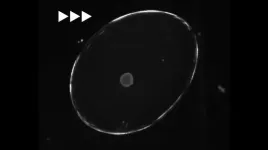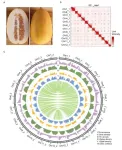(Press-News.org) PROVIDENCE, R.I. [Brown University] — Anyone who’s ever done a belly flop into a swimming pool knows it ends with a blunt-sounding splat, a big splash and a searing red sting. What most people don’t know is why.
Daniel Harris does. The assistant professor in Brown University’s School of Engineering says the physics behind the phenomenon aren’t too complex. What happens — and what makes it so painful, he explains — is that the forces from the water surface put up a fierce resistance to the body suddenly going from air to water, which is often still.
“All of a sudden, the water has to accelerate to catch up to the speed of what’s falling through the air,” said Harris, who studies fluid mechanics. “When this happens, that large reaction force is sent back to whatever's doing the impacting, leading to that signature slam.”
How and why this happens in fluid mechanics isn’t just important for developing a prize-winning belly flop for competitions, or dolling out pool-party trivia on why belly flops hurt so much — the understanding is critical to naval and marine engineering, which often have structures that need to survive high-impact air-to-water slamming forces. For that reason, the phenomenon has been studied thoroughly for the past century. But a research team led by Harris and Brown graduate student John Antolik found novel insights in a new study done in partnership with scholars at the Naval Undersea Warfare Center in Newport and Brigham Young University.
For the Journal of Fluid Mechanics study, the researchers set up a belly flop-like water experiment using a blunt cylinder but adding an important vibrating twist to it, which ultimately led them to counterintuitive findings.
“Most of the work that's been done in this space looks at rigid bodies slamming into the water, whose overall shape doesn't really change or move in response to the impact,” Harris said. “The questions that we start to get at are: 'What if the object that's impacting is flexible so that once it feels the force it can either change shape or deform? How does that change the physics and then, more importantly, the forces that are felt on these structures?”
To answer that, the researchers attached a soft “nose” to the body of their cylinder, referred to as an impactor, with a system of flexible springs.
The idea, Antolik explains, is that the springs — which act in principle similar to the suspension of a car — should help soften the impact by distributing the impact load over a longer period. This strategy has been floated as a potential solution for reducing sometimes catastrophic slamming impacts in air-to-water transitions, but few experiments have ever looked closely at the fundamental mechanics and physics involved.
For this experiment, the researchers dropped the cylinder repeatedly into still water and analyzed both the visual results and data from sensors embedded inside the cylinder.
This is where the unexpected happened.
The results show that while the strategy can be effective, surprisingly, it doesn’t always soften the impact. In fact, contrary to conventional thinking, sometimes the more flexible system can increase the maximum impact force on the body as compared to a fully rigid structure.
This forced the researchers to dig deeper. Through extensive experiments and by developing a theoretical model, they found their answer. Depending on the height from which the impactor is dropped and how stiff the springs are, the body will not only feel the impact from the slam but it will also feel the vibrations of the structure as it enters the water, compounding the slamming force.
“The structure is vibrating back and forth due to the violent impact, so we were getting readings from both the impact of hitting the fluid and an oscillation because the structure is shaking itself,” Harris said. “If you don't time those right, you can basically make the situation worse.”
The researchers found the key was the springs: they have to be soft enough to gently absorb the impact without leading to more rapid vibrations that add to the overall force.
Working in Brown’s Engineering Research Center, Antolik recorded the experiments using high-speed cameras and used an impact measurement tool called an accelerometer. “The whole back corner gets a little bit wet when I'm doing the experiments,” he joked.
The researchers are now looking at next steps in their research line, taking inspiration from diving birds.
“Biological studies of these birds have shown that they perform certain maneuvers as they enter the water to improve the conditions so they don't experience such high forces,” Antolik said. “What we're moving towards is trying to design what is essentially a robotic impactor that can perform some active maneuver during water entry to do the same for blunt objects.”
The study was supported by the Office of Naval Research and Naval Undersea Warfare Center.
END
Want the secret to less painful belly flops? These researchers have the answer.
Experiments by a Brown-led research team investigated belly flop mechanics and found surprising insights about air-to-water impacts that could be useful for marine engineering applications.
2023-11-06
ELSE PRESS RELEASES FROM THIS DATE:
Video technology could transform how scientists monitor changes in species evolution and development
2023-11-06
Scientists have made a major breakthrough in the study of species evolution, and provided further evidence that state-of-the-art visual technology can be used to track the tiniest changes in different organisms’ development.
New research used a combination of robotic video microscopes and computer vision to measure all of the observable characteristics of embryos of three different species.
These measurements were recorded as spectra of energy and, through this, scientists were able to compare shifts between species alongside previously documented differences in the timing of discrete developmental ...
KERI developed an alternative technology for ‘SF6’, the main culprit of global warming
2023-11-06
Korea Electrotechnology Research Institute (KERI) has developed a world-class 'eco-friendly insulating gas' that replaces SF6 (sulfur hexafluoride), the main cause of global warming in the field of electric power equipment, and developed a design technology to make it applicable to ultra-high voltage transmission circuit breakers.
Of course, power devices must be able to conduct electricity well but an ‘insulation’ function to block electricity is also essential to prepare for unexpected accidents and for safety reasons. SF6 gas offers excellent insulation and with far superior arc extinguishing performance than any other ...
Emergency departments saw firearm injuries in children double during pandemic
2023-11-06
Pediatric Emergency Department (ED) visits for firearm injuries doubled during the pandemic compared to earlier trends, according to a multicenter study published in the journal Pediatrics. During this time, deaths from firearm injuries in children and adolescents that occurred after arrival to the hospital also doubled – up from 3 percent of ED visits pre-pandemic to 6 percent of ED visits during the pandemic.
“With the pandemic we saw a drastic increase in firearm purchases, which might have led to the tragic spikes in injuries and deaths from firearms among children ...
High biological age may increase the risk of dementia and stroke
2023-11-06
People who have a higher biological age than their actual chronological age have a significantly increased risk of stroke and dementia, especially vascular dementia. These are the results of a study from Karolinska Institutet in Sweden published in the Journal of Neurology, Neurosurgery and Psychiatry.
The study, which was led by Sara Hägg, associate professor, and Jonathan Mak, doctoral student at the Department of Medical Epidemiology and Biostatistics, Karolinska Institutet, shows that the increased risk persists even if other risk factors such as genetics, lifestyle and socioeconomics are taken into account.
As we age, the risk of chronic diseases such as ...
New research shows quasars can be buried in their host galaxies
2023-11-06
-With pictures-
A new study reveals that supermassive black holes at the centres of galaxies, known as quasars, can sometimes be obscured by dense clouds of gas and dust in their host galaxies.
This challenges the prevailing idea that quasars are only obscured by donut-shaped rings of dust in the close vicinity of the black hole.
Quasars are extremely bright objects powered by black holes gorging on surrounding material.
Their powerful radiation can be blocked if thick clouds come between us and the quasar.
Astronomers have long thought this obscuring material only exists in the quasar's immediate surroundings, in a "dusty torus" (or donut) encircling it.
Now, a team of ...
EMBARGOED: Bendy X-ray detectors could revolutionize cancer treatment
2023-11-06
EMBARGOED: 0001 GMT MONDAY 6 NOVEMBER 2023
New materials developed at the University of Surrey could pave the way for a new generation of flexible X-ray detectors, with potential applications ranging from cancer treatment to better airport scanners.
Traditionally, X-ray detectors are made of heavy, rigid material such as silicon or germanium. New, flexible detectors are cheaper and can be shaped around the objects that need to be scanned, improving accuracy when screening patients and reducing risk when imaging tumours and administering radiotherapy.
Dr Prabodhi Nanayakkara, ...
Real-world analysis of sodium-glucose cotransporter-2 inhibitors in kidney transplant recipients
2023-11-04
Highlights
Compared with kidney transplant recipients who did not receive sodium-glucose cotransporter-2 inhibitors, those treated with the medications had lower risks of experiencing kidney transplant failure, kidney transplant rejection, major adverse cardiac events, all-cause mortality, and genitourinary infections.
Results from the study will be presented at ASN Kidney Week 2023 November 1–November 5.
Philadelphia, PA (November 4, 2023) — Sodium-glucose cotransporter-2 (SGLT2) inhibitors lower blood sugar levels and have additional beneficial effects on kidney and heart health for individuals with ...
Diagnostic outcomes of concurrent DNA and RNA sequencing in individuals undergoing hereditary cancer testing
2023-11-04
About The Study: The findings of this diagnostic study including 43,000 individuals undergoing hereditary cancer testing demonstrate that the ability to perform RNA sequencing concurrently with DNA sequencing represents an important advancement in germline genetic testing by improving detection of novel variants and classification of existing variants. This expands the identification of individuals with hereditary cancer predisposition and increases opportunities for personalization of therapeutics and surveillance.
Authors: Rachid Karam, M.D., Ph.D., of Ambry Genetics ...
The first semi-wild-type melon T2T genome assembled by Zhengzhou Fruit Research Institute, Chinese Academy of Agricultural Sciences, and China Agricultural University
2023-11-03
Melon (Cucumis melo L.) is an important vegetable crop that has an extensive history of cultivation, and has been classified into two subspecies, C. melo ssp. agrestis and C. melo ssp. melo. Previous study suggested that the two subspecies were domesticated independently [1], which may have generated different genetic mechanisms for the same trait between the two subspecies. Furthermore, the difference in their geographical distribution resulted in diverse characteristics between the two subspecies, shaping genomic imprinting in their genomes. Wild germplasm is an important genetic resource in crop breeding because of its high genetic diversity ...
Neighborhood stressors dangerously elevate pregnancy hormones
2023-11-03
Pregnant women living in blighted neighborhoods with high levels of known stressors have higher levels of testosterone – the primary sex hormone in males -- which disrupt hormone regulation and may lead to life-threatening complications during and after childbirth, according to Rutgers research.
“Previous research has shown that exposure to neighborhood stressors is associated with preterm birth, low birth weight and other complications such as preeclampsia, gestational diabetes and stillbirth,” ...
LAST 30 PRESS RELEASES:
Making lighter work of calculating fluid and heat flow
Normalizing blood sugar can halve heart attack risk
Lowering blood sugar cuts heart attack risk in people with prediabetes
Study links genetic variants to risk of blinding eye disease in premature infants
Non-opioid ‘pain sponge’ therapy halts cartilage degeneration and relieves chronic pain
AI can pick up cultural values by mimicking how kids learn
China’s ecological redlines offer fast track to 30 x 30 global conservation goal
Invisible indoor threats: emerging household contaminants and their growing risks to human health
Adding antibody treatment to chemo boosts outcomes for children with rare cancer
Germline pathogenic variants among women without a history of breast cancer
Tanning beds triple melanoma risk, potentially causing broad DNA damage
Unique bond identified as key to viral infection speed
Indoor tanning makes youthful skin much older on a genetic level
Mouse model sheds new light on the causes and potential solutions to human GI problems linked to muscular dystrophy
The Journal of Nuclear Medicine ahead-of-print tip sheet: December 12, 2025
Smarter tools for peering into the microscopic world
Applications open for funding to conduct research in the Kinsey Institute archives
Global measure underestimates the severity of food insecurity
Child survivors of critical illness are missing out on timely follow up care
Risk-based vs annual breast cancer screening / the WISDOM randomized clinical trial
University of Toronto launches Electric Vehicle Innovation Ontario to accelerate advanced EV technologies and build Canada’s innovation advantage
Early relapse predicts poor outcomes in aggressive blood cancer
American College of Lifestyle Medicine applauds two CMS models aligned with lifestyle medicine practice and reimbursement
Clinical trial finds cannabis use not a barrier to quitting nicotine vaping
Supplemental nutrition assistance program policies and food insecurity
Switching immune cells to “night mode” could limit damage after a heart attack, study suggests
URI-based Global RIghts Project report spotlights continued troubling trends in worldwide inhumane treatment
Neutrophils are less aggressive at night, explaining why nighttime heart attacks cause less damage than daytime events
Menopausal hormone therapy may not pose breast cancer risk for women with BRCA mutations
Mobile health tool may improve quality of life for adolescent and young adult breast cancer survivors
[Press-News.org] Want the secret to less painful belly flops? These researchers have the answer.Experiments by a Brown-led research team investigated belly flop mechanics and found surprising insights about air-to-water impacts that could be useful for marine engineering applications.






